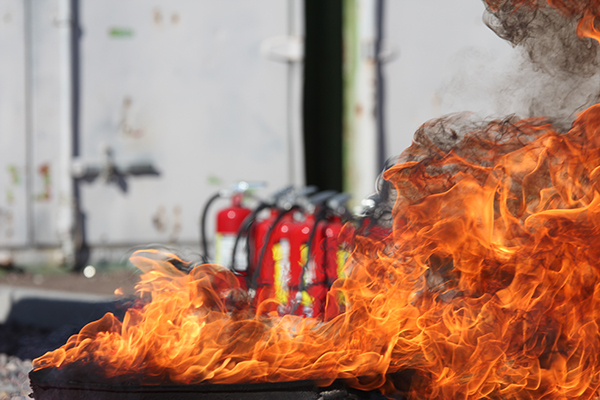Fire Extinguisher Series – Class E Extinguishers & How to Clean Up After Them
 Class E fires result from the combustion of cables, transformers and other electrical equipment. The sources of these fires are electrically energized equipment or electricity and are designated as Class C fires in some classification systems. The main risk involved in these fires is electrification or even electrocution that can cause further damage. It is therefore essential to cut the current first. Therefore, the appropriate fire extinguisher for Class E fires will mainly be CO2 and powder fire extinguishers.
Class E fires result from the combustion of cables, transformers and other electrical equipment. The sources of these fires are electrically energized equipment or electricity and are designated as Class C fires in some classification systems. The main risk involved in these fires is electrification or even electrocution that can cause further damage. It is therefore essential to cut the current first. Therefore, the appropriate fire extinguisher for Class E fires will mainly be CO2 and powder fire extinguishers.
Here’s our explanation on how to clean up after Class E fire extinguishers!
Class E Fire Extinguishers
Class E fires are fires caused by an electrical failure on electrical equipment that is still under voltage. The carbon dioxide extinguishing agent can overcome fires of electrical origin.
If the voltage is less than 1000 volts, you can also use a water extinguisher and spray additive, but with great care because water acts as a conductor.
The first step in putting out a Class E fire is to turn off the electrical power. When we cut the power, the fire becomes Class A, B or D depending on the materials that are burning. It is important to make sure that the electrical current has been completely cut off. Even if we have deactivated the power, another nearby circuit could power the circuit. Therefore, we have to be extra vigilant while putting out such a fire.
By drastically lowering the oxygen level in the air, carbon dioxide in the gas extinguisher smothers the fire. It is kept under pressure in the liquid state, and therefore at low temperature, it also acts by cooling (relatively, however, compared to water and foam).
As the outgoing gas is relatively cold (approximately -75/-80°C), there is a risk of frostbite linked to using this category of the extinguisher. This is why the diffuser is made of rubber to make it possible to grip it.
Carbon dioxide being lighter than the air above 179°C, explains the need to properly cover the entire surface occupied by the flames so that the gas can act. However, using a CO2 extinguisher is effective only against small Class E fires. For large fires, a dry chemical powder extinguisher should be used.
However, a CO2 extinguisher leaves no residue, unlike powder, and does not cause damage as water with an additive could do on electrical circuits, for example, which makes it an asset in a computer environment or the kitchen. It can also cool overheated electrical equipment. Be careful, however, of the risk of the explosion of suddenly cooling appliances.
How to Use Class E Fire Extinguishers?
Depending on whether a powder or CO2 extinguisher is used, different instructions must be followed to successfully put out a class E fire. In addition, depending on how much the fire’s spread, the extinguishing method may also differ.
Therefore, it is essential to find out beforehand about the instructions for handling the extinguishers that you may need to use. It is also very important to be aware of the environment in which one finds oneself, particularly the emergency exits and the equipment that could be damaged by exposure to extinguishing agents.
How to Clean Up After Class E Fire Extinguishers
Co2 extinguishers are more appropriate since they do not leave any residue. However, powder extinguishers have the disadvantage of spreading powder on all treated surfaces, which requires intensive cleaning of the disaster site. Electronics, in particular, are more sensitive to the action of powders. Here’s how you can clean up after Class E fire extinguishers!
- Brush the powder off objects that cannot be washed off with water, such as electrical equipment in this case. Place a trash can under the item and put the dust in there, or just put it on the floor.
- Collect as much powder as possible and throw it away. Alternatively, you can wash it down the drain or on the floor. The powder is not harmful to the environment.
- Use a vacuum to clean cracks and crevices that the broom can’t reach. Check below and in the middle of the elements.
- Wash off any remaining dust with soap and water, or simply rinse off with a hose. However, check your fire extinguisher ingredients first. Some use mono ammonium phosphate, which can be mildly corrosive to metals. These are generally used in hospitals and laboratories. If so, you will need to scrub any dust-covered surface to prevent corrosion carefully.
Although the appropriate extinguishers can extinguish fires of any class, it should be done with extra care and seek professional help, especially in cases where energized electrical equipment is involved. Also, cleaning the residue after using a powder extinguisher from electrical components isn’t as easy as it sounds. Therefore, leaving this job to a proper fire damage restoration and sanitization professional will leave you with peace of mind!
If you’re looking for a fire damage restoration company in Virginia Beach or in the surrounding area, contact 911 Restoration of Virginia Beach. The 911 Restoration of Virginia Beach team has certified and trained professionals who carry out the restoration and sanitization services in compliance with the protocols. Call (757) 324-5276 or visit their website for more information.



